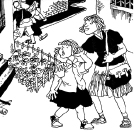View
Restore a past that was really glamorous
By Chen Weihua
Updated: 2009-08-14 00:00
 |
Large Medium Small |

Every night after dinner, young women — many provocatively dressed or in skimpy outfits and heavy makeup — strut the sidewalks to their workplace at plush nightclubs and KTV parlors in the neighborhood. Rain or storm, their patrons arrive in droves in their luxury sedans. These neon-lit, low-key clubs are a haven for men with yuan-filled pockets, where money buys them endless pleasures for the night, and into the early morning.
For years, I have been worried about these bad influences on my daughter. Such vibrant and decadent nightlife spots have made our community a less desirable place to raise children. If Mencius’ mother were alive today, she would immediately choose to move out of this area. The mother of the ancient Chinese philosopher relocated three times to find an ideal environment to raise her son.
In the past two decades, Shanghai’s nightlife has changed drastically, though it by no means compares to the locals’ memory of the city’s glorious past. While the city has been trying to regain its fame of the 1920s and 30s as the “Paris of the East”, it never wants to mention its once humiliating sobriquet, the “Whore of Asia”.
Fuzhou Road, which is lined with bookstores today, used to be full of brothels and opium dens. In the space currently occupied by the towering Raffles City were small stone-arched houses, which were home to 151 brothels. At one time, the number of prostitutes in Shanghai was estimated to be more than 100,000. They included some 10,000 from overseas, such as Russia and Japan.
The establishment of the People’s Republic of China in 1949 signaled an end to the sex industry. By November 1951, the number of brothels in Shanghai fell dramatically, from 500 in January in 1949 to 79. The same month, Chen Yi, Shanghai’s first Communist mayor, whose statue on the Bund now overlooks Fuzhou Road, ordered the closure of all the brothels in the city. Many Chinese and foreign prostitutes were treated for venereal diseases while receiving re-education in a women’s reformatory at 418 Tongzhou Road on the northeast end of the city. A sign hanging on the gate then read: “Old society turned humans into ghosts. New society transforms ghosts back to humans.”
The historic facility is no longer discernible because it has given way to new residential apartments.
Thousands of women completed their education programs there in the 1950s, learning to appreciate the value of life and hard work. The textile and hosiery products they made were called xin sheng, meaning new life.
In fact, during a massive Labor Day parade in Shanghai in 1953, one eye-catching squadron in the matrix comprised young women holding a signboard that read: Shanghai Women’s Correction House. Some women later became factory workers. Many others went to work on farms in other provinces or regions.
Recalling the past is bitter, but absolutely necessary for us in order to look toward a better future. I do not have any ill will toward the women who catwalk the neighborhood streets in four-inch heels, or those working among the city’s abundant pink-light massage houses.
I just feel there is a need for a zoning law to separate these nightlife spots from our apartments so people can raise their children in a safe and clean environment. And while reform-through-labor may be a system much too controversial for our modern times, it is important that we find suitable means to teach everyone the value of life and hard work.
chenweihua@chinadaily.com.cn